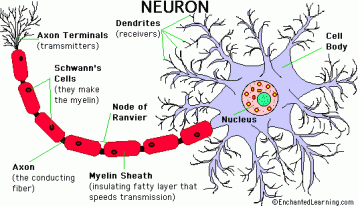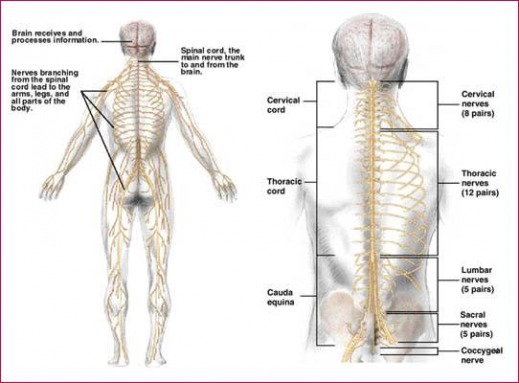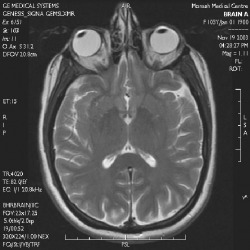Neurons

The basic nerve cell of the nervous system. A neuron consists of a nucleus within a cell body and one or more processes (extensions) called dendrites and axons.
The nerve a bundle of nerve fibers (axons). Fibers are either afferent (leading toward the brain and serving in the perception of sensory stimuli of the skin, joints, muscles, and inner organs) or efferent (leading away from the brain and mediating contractions of muscles or organs).
Information taken from:
Fentress, John C. "nervous system." Grolier Multimedia Encyclopedia. 2008. Grolier Online. 20 Nov. 2008 <http://gme.grolier.com/cgi-bin/article?assetid=0206170-0>.
Neurotransmitters
Neurotransmitters are chemicals that relay messages between neurons and other cell The area between a neuron and a axon is called a synapse.This is the are in which a neurotransmitter operates. The neurotransmitter receptors are specialized proteins embedded in the receiving neuron's synaptic membrane. They receive and interpret the information relayed by the neurotransmitter. An agonist is a compound that mimics the action of a neurotransmitter. It bind itself to a neural receptor and alters its function Agonist can be used as drugs in the treatment of disease such as Parkinson's (by binding dopamine receptors in the brains) An antagonist is a compound that blocks or inhibits the action of a neurotransmitter .
Serotonin - In the central nervous system, serotonin plays an important role as a neurotransmitter in the modulation of anger, aggression, body temperature, mood, sleep, sexuality, appetite, and metabolism
Dopamine-has many functions in the brain, including important roles in behavior and cognition, motor activity, motivation and reward, inhibition, sleep, mood, attention, and learning.
Acetycholine-Acetylcholine has functions both in the peripheral nervous system (PNS) and in the central nervous system (CNS) as a neuromodulator. In the PNS, acetylcholine activates muscles, and is a major neurotransmitter in the autonomic nervous system. In the CNS, acetylcholine and the associated neurons form a neurotransmitter system, the cholinergic system, which tends to cause excitatory actions.
Fentress, John C. "nervous system." Grolier Multimedia Encyclopedia. 2008. Grolier Online. 20 Nov. 2008 <http://gme.grolier.com/cgi-bin/article?assetid=0206170-0>.
Nervous System

The CNS includes the brain and the spinal cord and is the control network for the entire body.
The peripheral nervous system (PNS) resides or extends outside the central nervous system (CNS)The main function of the PNS is to connect the CNS to the limbs and organs
Related links:
http://www.beechwoodchiropractic.com/yourbody.php
Neuroimaging

MRI
A diagnostic technique in which radio waves generated in a strong magnetic field are used to provide information about the hydrogen atoms in different tissues within the body; a computer uses this information to produce images of the tissues in many different planes.
PET
a highly specialized imaging technique. The acronym stands for Positron Emission Tomography, which literally means to send forth an internal body image with the use of positively charged particles
CAT
A computerized imaging method that takes multiple cross-section x-ray images of soft tissues.
EEG
Electroencephalogram; a diagnostic test which records the brain’s electrical activity or "brain waves". It does not provide a diagnosis of epilepsy, but can help distinguish types of seizures, or where seizures begin in the brain.
fMRI
stands for "functional magnetic resonance imaging". It is a neuroimaging technique used to study activity in the brain. It shows which structures are active during particular mental operations.
Information Taken From
http://science-education.nih.gov/supplements/nih5/Mental/other/glossary.htm
